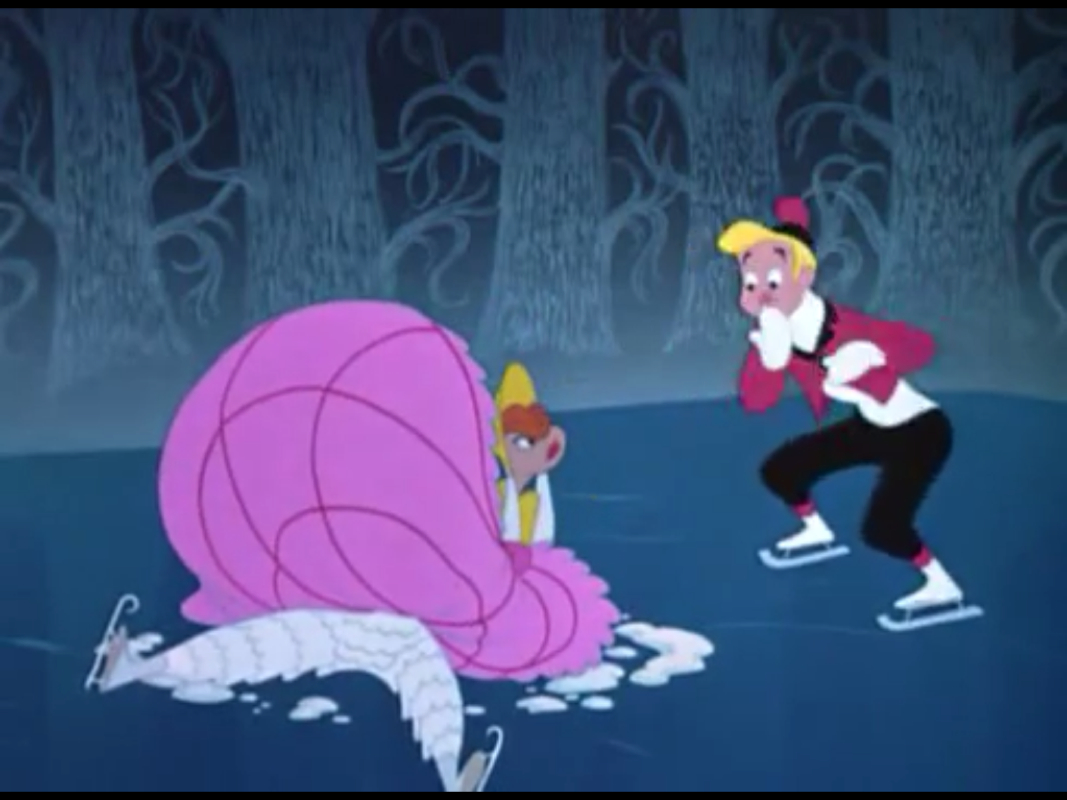Tim here. We're talking about 1948 this week at the Film Experience, and it's my turn to take you back to the world of American animation in the aftermath of World War II. It was a fertile period: of the three studios that had dominated the medium prior to the war, Fleischer had been absorbed into Paramount and disappeared, while Disney had been badly damaged by an animators strike in 1941 and the loss of overseas markets, and spent the second half of the decade in desperate survival mode. That left a vacuum, which was filled by a sprawling variety of competitors that thrived even after Disney managed to find its footing again.

Pictured: Disney in 1948. Literally: it's from their film Melody Time.
In tribute to this unusually diverse marketplace, arguably not matched again in theatrical animation until the early 2000s, may I present three of the most unique and important animated milestones of 1948 after the jump...
Haredevil Hare
Bugs Bunny - (Ep. 64) - Haredevil Hare 2015 by serijedomace04
The basic ingredients are Bugs Bunny stock material: the rascally rabbit is inadvertently dumped in an unexpected environment where some hapless bad guy is up to mischief, and it's up to Bugs to show the chump who's boss. And as far as that's concerned, it's not even a terribly exciting Bugs short: it has too much plot and not enough jokes, nor, for the most part, are those jokes particularly creative. It does have, though, an early expression of one of Chuck Jones's more admirable preoccupations as a filmmaker, in a stretched-out gag that runs Bugs's body through a cubist ringer in order to find out just how much you can bend around an animated character before he becomes grotesque.

That being said, the film stands out much more for its plot hook: it involves stuffing Bugs in a rocket and shooting him to the moon, right at the very start of pop culture's space age obsession. In fact, I believe it's the very first post-war cartoon involving rocket ships and space travel. To inaugurate this new and soon to be inescapable genre, it even introduced a new foil for Bugs:

Marvin the Martian, though not named until many years later, made his debut here as a new, more intelligent and legitimately dangerous villain, to compensate for the animators' boredom with the loud idiot Yosemite Sam. The character made a shocking small number of appearances: a grand total of five shorts through 1963. But he became an immensely popular character through merchandising, and remains one of the most iconic of all Looney Tunes villains. His first appearance is maybe his least characteristic - Mel Blanc used an entirely different voice than he'd later develop - but the oddball design of the character and his real sense of menace were intact from the start, and he's easily the best reason to revisit the short in later years.
Wet Blanket Policy (makes Oscar history!)
Not even close to the first Woody Woodpecker cartoon cranked out by Walter Lantz Productions, but it was the first to include the character's theme song (after the fact, and it is overlaid atop the movie rather than worked into it). That, in turn, greased its way into the history books: the George Tibbles and Ramey Idriess composition received an Oscar nomination, making this the only animated short to have received Academy notice in that category. I confess that my tedious modern ears don't at all hear what makes the song worthy of that kind of attention, or distinctive in any way at all, but it was an astonishingly big hit in '48.

It's also the most distinctive element of the film, which is otherwise largely run-of-the-mill cartoon slapstick of a sort that Woody had been engaging in for most of his seven years of existence. Though like Bugs, he got a new antagonist in this trip to bat, in the form of murderous insurance salesman Buzz Buzzard, and that character made for enough of a shift in the series' comedy that Wet Blanket Policy is a bit more enjoyable than several of the other Woody shorts of the era. Still, the character was always inherently limited, and even the best gags here will be fairly familiar to anybody who's seen more than a handful of these "wacky violence" comic shorts.
Robin Hoodlum
The film of this list that most badly suffers from being undone by its own successors. This was the very first project completed and released by United Productions of America, a group made up in no small part of refugees from Disney, looking to make more stylistically adventurous cartoons for a more modern-thinking audience. And in 1948, folks saw enough here that the film picked up a nomination for Best Short Subject, Cartoon. It's possible to work hard enough to see its sarcastic sense of humor and hip tone as wildly contemporary, a rebuild of the Fox and Crow characters who had been sitting around for most of a decade that redirects the style of their series into something edgier - there is social commentary! Coffee-drinking hipster Merry Men!

But in hardly any time, UPA would push forth in new directions that leave this short in the dust. Their jazzy, minimalist style of the '50s leaves the "cheap Looney Tunes" aesthetic of Robin Hoodlum looking positively quaint, and even in this amped-up form, the recycled characters on display simply can't be as fresh and grown-up as the leads of many a UPA short yet to come. Still, one of the most impressive and important (and sadly invisible, much too often) runs in American animation started right here, and that is worthy of genuflection and respect, even if this particular short feels a bit more conventional than it actually was.